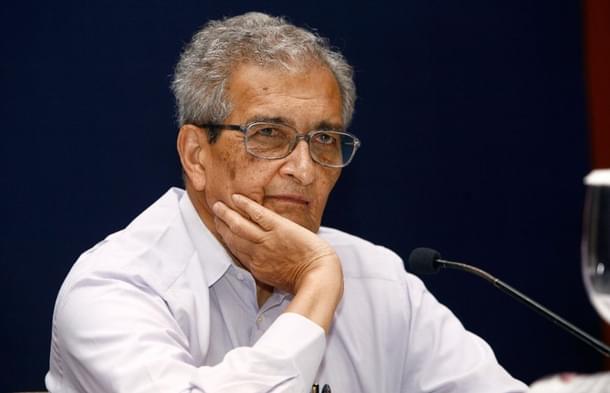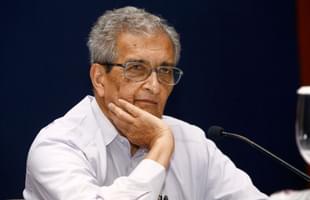Politics
Why Amartya Sen Needs To Update Himself On India’s Real ‘Battle Of Ideas’
Swati Kamal
May 30, 2019, 12:46 PM | Updated 12:46 PM IST
Save & read from anywhere!
Bookmark stories for easy access on any device or the Swarajya app.


In an article in The New York Times, economist Amartya Sen had this to say about the Bharatiya Janata Party (BJP) win in the recent elections: “The Hindu nationalist movement has won something in terms of power but nothing particularly serious in the battle of ideas.” Being an Amartya Sen piece, it finds wide circulation, especially among the educated.
The phrase ‘battle of ideas’ especially caught one’s fancy and one read it several times over, only to be disappointed. One felt, finally, that the somewhat obfuscatory article had something in terms of wordplay that lent intrigue to the existing, hackneyed arguments — but was nothing particularly scholarly about the battle of ideas.
If Sen is trying to say that the sentiment of nationalism that has caught on is bereft of ideas, he may well update himself to the fact that by now, nationalism is entrenched in the psyche of intellectuals also. And yes, their ideas do go further back than Rabindranath Tagore, Mahatma Gandhi and Jawaharlal Nehru, who he mentions.
As for the masses who voted the Modi government back, they are not expected to be motivated by ideas per se, but by actions that reflect those ideas. Sen may, literally, be far removed from reality, but all he really needs to do is watch ground report videos of the poor in rural and remote areas, in the run-up to the election. They invariably said they would vote “for only Modi because he was doing so much” for them.
The fact is, it is the ‘ideas’ of Hinduism’s inclusiveness and unity that his schemes betray. Without discrimination and without appeasement, Swachh Bharat, Beti Bachao Beti Padhao, Poshan, Ujjwala, Ayushman Bharat and others delivered.
So, to speak of Sen’s ‘realm of ideas’ and that ‘India has changed’, there is certainly an element of truth in them. Says Dr Arun Tiwari, well-known missile scientist and close associate of former president A P J Abdul Kalam: “Modi ji finally defeated the game of keeping people poor and destitute so that incompetent people could rule them”.
An Irony, And A Regrettable One At That
Interestingly, Modi’s schemes touched upon exactly those areas that the doctors — Sen and Jean Dreze — had ordered, in an article in 2011. In this longish piece, the authors had argued — almost admonished Indian policymakers — that though India’s growth numbers (then, in 2011) were “marvelous, the progress of living standards for common people, as opposed to a favored minority, has been dreadfully slow”.
They emphasised that “growth can be helpful in achieving development, but not without active public policies especially related to healthcare and education”. They admitted that it may be difficult in a democracy like India (compared with China, an authoritarian system where it is easier to tailor policies).
A review of Team Modi’s efforts in this area shows that the schemes — Swachh Bharat, Beti Bachao Beti Padhao, Poshan, Ujjwala, Ayushman Bharat — targeted exactly those areas that Team Sen-Dreze had highlighted with indicators to showcase India’s dismal state of development and where “imaginative democratic practice” was needed. These were “access to improved sanitation”, “female literacy” “maternal and child health, malnutrition and mortality!”
Hence, it is regrettable that Sen in his latest piece that talks about “battles” and “war”, does not talk about the larger battle that Modi fought in the last five years, against poverty. Rather strange for an economist, who got the Nobel prize for his contributions to welfare economics and for “his interest in the problems of society’s poorest members”.
Modi’s development schemes are direct attacks on social sector indicators, and even if they are works-in-progress, “progress” is the operative word.
Beyond Development, Addressing Poverty Through Productivity Increase
But Modi’s victory goes beyond even the development and welfare measures, which are already several notches above what these development economists had suggested: he chose to invest in the poor to increase their productivity — a lasting solution to address poverty.
Dr Tiwari points out that Prime Minister Modi has done what Piloo Mody, erstwhile politician and founding member of Swatantra Party, had famously said in 1979:
“It has now been established beyond any dispute that the only method of eradicating poverty is to make the poor productive. Everything else — doles, subsidies, even social justice — is that much sentimental slobbery meant to appease rather than to provide a lasting solution. To make the poor productive requires economic justice — the right to learn and possess technology and the right of access to resources for putting to use”.
According to Dr Tiwari, “an honest effort was made to empower people. While Congress kept on harping loan waivers and jobs in the government, Prime Minister Modi rolled out MUDRA to help youth start their small enterprises. In the depth and breadth of the election victory of Modi ji, the rise of one billion people is so openly evident.”
Let that idea sink in.
The Indigenous, Commonsense, Development Economist
Net-net, one can say that the indigenous, commonsense economist in Modi employed a two-pronged approach: on the one hand, he created an enabling atmosphere through Ayushman Bharat, Swachh Bharat, Ujjwala, PMAY, Saubhagya, Jan Dhan et al. This eased lives and added intangibly to productivity by taking care of the healthcare, sanitation and availability of toilets, ownership of homes, availability of electricity and bank accounts.
Simultaneously, enhancement of productivity through training and skills through Skill India and the allied PMKVY (Pradhan Mantri Kaushal Vikas Yojana), SANKALP (Skill Acquisition and Knowledge Awareness for Livelihood Promotion Programme) and Skill Loan scheme.
Continuous seeking of employment opportunities seemed to be the spur. And hence, international partnerships within Skill India, training in rural areas in Japanese-style of manufacturing, exposure to UK culture through virtual learning, and even courses in foreign languages to prepare youngsters for jobs abroad.
People with disabilities benefitted, and even existing artisans whose skills were enhanced through introduction of technology and new consumer demands. And across sectors — construction, carpet-weaving, brick-laying, BPOs, graphic designing, robotics and even EVs (electric vehicles).
Further, as Dr Tiwari points out, easy loans through MUDRA were especially beneficial, through which people could build on their interests and become small-scale entrepreneurs. Reportedly, until 22 March, the Mudra sanctions had helped 541.27 lakh very small businesses.
Employment opportunities were an important priority in the Digital India and DigiGaon programmes. Even the LPG scheme, Ujjwala, helped in increasing the productivity of women, who were left with spare time, after finishing cooking on a faster mode. This extra time they utilised in taking up activities like sewing, tailoring to earn income.
Like Piloo Mody had said, the Modi government gave its people “the right to learn and possess technology and the right of access to resources for putting to use”.
Critics may argue that the measures have not shown success uniformly. Granted, that skilling schemes need to be calibrated appropriately, and then transition to high skills equilibrium by creating demand, is needed.
Yet, the average Indian, who is used to battling adversity stoically, is patient and willing to go through teething troubles. They are also good at perceiving sincerity of purpose.
Sen may be right about ‘power’ powering Modi’s win: It is the power of the ideas and imagination, which sought to use commonsense to understand the real issues — and then, the power of purpose in pushing through the processes to achieve those objectives. In the end, it is still a victory of ideas and imagination.
And, ultimately — it was powered by the idea of India, still largely driven by the Hindu heart and soul, which is inherently inclusive and liberal and seeks unity.
Unfortunately, Sen, the economist, chose to talk only about generalities like India’s “slow growth”, “high unemployment” and such like, when acknowledgedly the gig economy trend is here to stay, where the government’s role in providing employment is limited.
For the information of esteemed economists like him, a McKinsey Global Institute report said that “the so-called gig economy (or increase in independent work opportunities available), government spending and the consequent creation of jobs, and increased entrepreneurial activity have created gainful employment for between 20 million and 26 million people between 2014 and 2017”.
Governments can only arm people with skills, resources, and remove hurdles in their way. Looks like Modi got that better.
Swati Kamal is a columnist for Swarajya.





